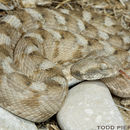en
names in breadcrumbs


Nocturnal and crepuscular, most active at or just after sunset.
Least Concern
A medium-sized snake, with a short, stocky body. Largest Egyptian specimen has a total length of 530 mm, up to 750 mm elsewhere. Tail short, tail / total length = 0.09-0.12. It has 12-15 supralabials; eye moderate, separated from supralabials by 3-4 scales, pupil vertical; scales on dorsal side of head moderate, 13-15 interorbitals; dorsals strongly keeled, 31-35 scale rows around mid-body; 174-205 ventrals, 42-52 single subcaudals; anal entire. Dorsum buffish gray, with a mid-dorsalseries of dark-edged pale-gray saddles, interspersed with large rufous-brown blotches; a lateral series of smaller dark spots; dorsal side of head plain brownish; a diagnostic broad, dark-gray band, from the eye to corner of mouth. Venter white.
The Eastern Desert and Sinai. Widespread, but uncommon, in the Eastern Desert; the southernmost record known from Egypt is from Bir Abraq (UMMZ 181529). However, Joger (1987) reports the species further south from northeast Sudan. In Sinai it is fairly common, but is lacking from the dune fields of the north. Venomous to humans.
Eastern Egypt and Sudan, and Arabia.
A species of rocky mountainous country, typically found on rather steep slopes with boulders, on ledges, cliffs and rocky wadis. Often near or in oases and near water sources. In South Sinai found up to 2,000 m, and probably reaches higher altitudes. Nocturnal and crepuscular, most active at or just after sunset.
Fairly common and widespread
Echis coloratus, known as the painted saw-scaled viper,[3] painted carpet viper, Burton's carpet viper,[4] and by other common names, is a highly venomous viper species endemic to the Middle East and Egypt.[2] No subspecies are currently recognized.[5]
It grows to a maximum total length (body + tail) of 75 cm (30 in).[3]
Painted saw-scaled viper,[3] painted carpet viper, Burton's carpet viper,[4] Palestine saw-scaled viper,[6] Arabian saw-scaled viper,[7] Mid-East saw-scaled viper.[7]
It is found in the Middle East in Sinai, Israel, and Jordan. On the Arabian Peninsula it has been recorded from Saudi Arabia, Yemen, and Oman. In Africa it occurs in eastern Egypt east of the Nile and as far south as the 24th parallel.
The type locality given is "on Jebel Shárr, at an altitude of 4500 feet ... Midian" (Saudi Arabia, 1371 m altitude).[2]
It occurs in rocky deserts, from sea level to altitudes as high as 2,500 m (8,200 ft). It is not found in sandy deserts.[4]
In order to maintain nomenclatural stability, Stimson (1974) proposed that E. coloratus be validated over E. froenata. The ICZN subsequently gave coloratus precedence over froenata by use of its plenary powers.[2]
Echis coloratus, known as the painted saw-scaled viper, painted carpet viper, Burton's carpet viper, and by , is a highly venomous viper species endemic to the Middle East and Egypt. No subspecies are currently recognized.